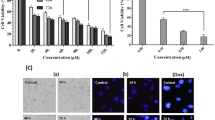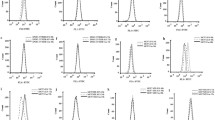Summary
We report herein the reversal of multidrug resistance-1 (MDR1) in A2780/DX3 cells by the two nifedipine-like compounds 1 and 2 that are part of a library of 1,4-dihydropyridines (1,4-DHPs) calcium-channel modulators bearing in C-4 a different substituted imidazo[2,1-b]thiazole system. By methylthiazol tetrazolium (MTT) assay, cytofluorimetry, and fluorescence microscopy we evaluated their ability to reverse MDR in our cell system. Moreover, together with compound 3 (the diltiazem-like 8-(4-chlorophenyl)-5-methyl-8-[(2Z)-pent-2-en-1-yloxy]-8H-[1,2,4]oxadiazolo[3,4-c][1,4]thiazin-3-one) we analyzed their ability to potentiate the triggering of apoptosis after exposure to doxorubicin, through the nuclear morphological analysis after 4′,6-diamidino-2-phenylindole (DAPI), the fluorescein isothiocyanate (FITC)-Annexin-V/propidium iodide (PI) staining and the caspase activity determination. Our results demonstrate that compounds 1 and 2, at concentrations showing a very low (5%) or absent inhibition of cell proliferation, in combination with doxorubicin enhance its antiproliferative activity (from 30% to 54% IC50 reduction) in A2780/DX3 cells through an increase of doxorubicin intracellular accumulation. These compounds together with compound 3, which has already been demonstrated to act as a potent inhibitor of MDR1 function, were also able to significantly potentiate the activation of the apoptosis machinery triggered by the exposure to doxorubicin. In conclusion, our results identify two new molecules structurally related to the calcium-channel blocker nifedipine, but characterized by a very low LTCC blockers activity, able to potentiate the antiproliferative and apoptotic activities of doxorubicin through an increase of its intracellular concentration likely caused by the inhibition of MDR1 function.






Similar content being viewed by others
References
Abolhoda A, Wilson AE, Ross H, Danenberg PV, Burt M, Scotto KW (1999) Rapid activation of MDR1 gene expression in human metastatic sarcoma after in vivo exposure to doxorubicin. Clin Cancer Res 5:3352–3356
Kourti M, Vavatsi N, Gombakis N, Sidi V, Tzimagiorgis G, Papageorgiou T, Koliouskas D, Athanassiadou F (2007) Expression of multidrug resistance 1 (MDR1), multidrug resistance-related protein 1 (MRP1), lung resistance protein (LRP), and breast cancer resistance protein (BCRP) genes and clinical outcome in childhood acute lymphoblastic leukemia. Int J Hematol 86:166–173
Hille S, Rein DT, Riffelmann M, Neumann R, Sartorius J, Pfützner A, Kurbacher CM, Schöndorf T, Breidenbach M (2006) Anticancer drugs induce mdr1 gene expression in recurrent ovarian cancer. Anticancer Drug 17:1041–1044
Sharom FJ (2008) ABC multidrug transporters: structure, function and role in chemoresistance. Pharmacogenomics 9:105–127
Sarkadi B, Homolya L, Szakács G, Váradi A (2006) Human multidrug resistance ABCB and ABCG transporters: participation in a chemoimmunity defense system. Physiol Rev 86:1179–1236
Li X, Li JP, Yuan HY, Gao X, Qu XJ, Xu WF, Tang W (2007) Recent advances in P-glycoprotein-mediated multidrug resistance reversal mechanisms. Meth Find Exp Clin Pharmacol 29:607–617
Sharom FJ (2006) Shedding light on drug transport: structure and function of the P-glycoprotein multidrug transporter (ABCB1). Biochem Cell Biol 84:979–92
Fromm MF (2004) Importance of P-glycoprotein at blood-tissue barriers. Trends Pharmacol Sci 25:423–429
Mechetner E, Kyshtoobayeva A, Zonis S, Kim H, Stroup R, Garcia R, Parker RJ, Fruehauf JP (1998) Levels of multidrug resistance (MDR1) P-glycoprotein expression by human breast cancer correlate with in vitro resistance to taxol and doxorubicin. Clin Cancer Res 4:389–398
Lum BL, Gosland MP, Kaubisch S, Sikic BI (1993) Molecular targets in oncology: implications of the multidrug resistance gene. Pharmacotherapy 13:88–109
Avedaño C, Menéndez JC (2002) Inhibitors of multidrug resistance to antitumor agents (MDR). Curr Med Chem 9:159–193
Krishna R, Mayer LD (2000) Multidrug resistance (MDR) in cancer. Mechanisms, reversal using modulators of MDR, and the role of MDR modulators in influencing the pharmacokinetics of anticancer drugs. Eur J Pharm Sci 11:265–283
Ferry DR, Traunecker H, Kerr DJ (1996) Clinical trials of P-glycoprotein reversal in solid tumors. Eur J Cancer 32A:1070–1081
Fischer V, Rodríguez-Gascón A, Heitz F, Tynes R, Hauck C, Cohen D, Vickers AE (1998) The multidrug resistance modulator Valspodar (PSC 833) is metabolized by human cytochrome P450 3A. Implications for drug-drug interactions and pharmacological activity of the main metabolite. Drug Metab Dispos 26:802–811
Wandel C, Kim RB, Kajiji S, Guengerich P, Wilkinson GR, Wood AJP (1999) Glycoprotein and cytochrome P-450 3A inhibition: dissociation of inhibitory potencies. Cancer Res 59:3944–3948
Vergouwen MD, Vermeulen M, de Haan RJ, Levi M, Roos YB (2007) Dihydropyridine calcium antagonists increase fibrinolytic activity: a systematic review. J Cereb Blood Flow Metab 27:1293–1308
Sahney S (2006) A review of calcium channel antagonists in the treatment of pediatric hypertension. Paediatr Drugs 8:357–373
Holmes FA, Lopez A, Mavligit G, Fraschini G, Frye D, Hortobagyi GN (1997) Secondary drug resistance in breast cancer: failure to reverse with oral nifedipine. Int J Cancer 73:184–186
Philip PA, Joel S, Monkman SC, Dolega-Ossowski E, Tonkin K, Carmichael J, Idle JR, Harris AL (1992) A phase I study on the reversal of multidrug resistance (MDR) in vivo: nifedipine plus etoposide. Br J Cancer 65:267–270
Li X, Lu WL, Liang GW, Ruan GR, Hong HY, Long C, Zhang YT, Liu Y, Wang JC, Zhang X, Zhang Q (2006) Effect of stealthy liposomal topotecan plus amlodipine on the multidrug-resistant leukaemia cells in vitro and xenograft in mice. Eur J Clin Invest 36:409–418
Li X, Ruan GR, Lu WL, Hong HY, Liang GW, Zhang YT, Liu Y, Long C, Ma X, Yuan L, Wang JC, Zhang X, Zhang Q (2006) A novel stealth liposomal topotecan with amlodipine: apoptotic effect is associated with deletion of intracellular Ca2+ by amlodipine thus leading to an enhanced antitumor activity in leukemia. J Control Release 112:186–198
Budriesi R, Cosimelli B, Ioan P, Lanza CZ, Spinelli D, Chiarini A (2002) Cardiovascular characterization of [1, 4]thiazino[3, 4-c][1, 2, 4]oxadiazol-1-one derivatives: Selective myocardial calcium channel modulators. J Med Chem 45:3475–3481
Budriesi R, Carosati E, Chiarini A, Cosimelli B, Cruciani G, Ioan P, Spinelli D, Spisani R (2005) A new class of selective myocardial calcium channel modulators. 2. Role of the acetal chain in oxadiazol-3-one derivatives. J Med Chem 48:2445–2456
Viale M, Cordazzo C, Cosimelli B, de Todero D, Castagnola P, Aiello C, Severi E, Petrillo G, Cianfriglia M, Spinelli D (2009) Inhibition of MDR1 activity in vitro by a novel class of diltiazem analogues: towards new candidates. J Med Chem 52:259–66 see also SciBX, doi:10.1038/scibx.2009.44
Budriesi R, Ioan P, Locatelli A, Cosconati S, Leoni A, Ugenti MP, Andreani A, Di Toro R, Bedini A, Spampinato S, Marinelli L, Novellino E, Chiarini A (2008) Imidazo[2, 1-b]thiazole system: A scaffold endowing dihydropyridines with selective cardiodepressant activity. J Med Chem 51:1592–1600
Phillips AP (1949) Hantzsch’s pyridine synthesis. J Am Chem Soc 71:4003–4007
Andreani A, Granaiola M, Leoni A, Locatelli A, Morigi R, Rambaldi M, Garaliene V, Welsh W, Arora S, Farruggia G, Masotti L (2005) Antitumor activity of new substituted 3-(5-imidazo[2, 1-b]thiazolylmethylene)-2-indolinones and study of their effect on the cell cycle. J Med Chem 48:5604–5607
Hussain RF, Nouri AME, Oliver RTD (1993) A new approach for measurement of cytotoxicity using colorimetric assay. J Immunol Methods 60:89–96
Novi M, Ottone M, Dell’Erba C, Barbieri F, Chiavarina B, Maccagno M, Viale M (2004) 1, 4-Bis(1-naphthyl)-2, 3-dinitro-1, 3-butadiene a novel anticancer compound effective against tumor cell lines characterized by different mechanisms of resistance. Oncol Rep 12:91–96
Qi J, Yang CZ, Wang CY, Wang SB, Yang M, Wang JH (2002) Function and mechanism of pyronaridine: a new inhibitor of P-glycoprotein-mediated multidrug resistance. Acta Pharmacol Sin 23:544–550
Beck WT, Qian XD (1992) Photoaffinity substrates for P-glycoprotein. Biochem Pharmacol 43:89–93
Gonzales VM, Fuertes MA, Alonso C, Perez JM (2001) Is cisplatin-induced cell death always produced by apoptosis? Mol Pharmacol 59:657–663
Kerr JF, Winterford CM, Harmon BV (1994) Apoptosis. Its significance in cancer and cancer therapy. Cancer 73:2013–2026
Fuster JJ, Sanz-González SM, Moll UM, Andrés V (2007) Classic and novel roles of p53: prospects for anticancer therapy. Trends Mol Med 13:192–199
Gadducci A, Cosio S, Muraca S, Genazzani AR (2002) Molecular mechanisms of apoptosis and chemosensitivity to platinum and paclitaxel in ovarian cancer: biological data and clinical implications. Eur J Gynaecol Oncol 23:390–396
Lerma-Díaz JM, Hernández-Flores G, Domínguez-Rodríguez JR, Ortíz-Lazareno PC, Gómez-Contreras P, Cervantes-Munguía R, Scott-Algara D, Aguilar-Lemarroy A, Jave-Suárez LF, Bravo-Cuellar A (2006) In vivo and in vitro sensitization of leukemic cells to adriamycin-induced apoptosis by pentoxifylline. Involvement of caspase cascades and IkappaBalpha phosphorylation. Immunol Lett 103:149–158
Yoshimoto Y, Kawada M, Ikeda D, Ishizuka M (2005) Involvement of doxorubicin-induced Fas expression in the antitumor effect of doxorubicin on Lewis lung carcinoma in vivo. Int Immunopharmacol 5:281–288
Wu S, Ko YS, Teng MS, Ko YL, Hsu LA, Hsueh C, Chou Y, Liew CC, Lee YS (2002) Adriamycin-induced cardiomyocyte and endothelial cell apoptosis: in vitro and in vivo studies. J Mol Cell Cardiol 34:1595–1607
Acknowledgements
This research was supported by funds from “Ministero dell’Istruzione, dell’Università e della Ricerca” (FIRB 2001, PRIN-2005034305_001, PRIN-20078J9L2A_005) and from the University of Bologna. Dr. M. Croce is recipient of a fellowship by “Fondazione italiana per la lotta al neuroblastoma”.
Author information
Authors and Affiliations
Corresponding authors
Rights and permissions
About this article
Cite this article
Viale, M., Cordazzo, C., de Totero, D. et al. Inhibition of MDR1 activity and induction of apoptosis by analogues of nifedipine and diltiazem: an in vitro analysis. Invest New Drugs 29, 98–109 (2011). https://doi.org/10.1007/s10637-009-9340-7
Received:
Accepted:
Published:
Issue Date:
DOI: https://doi.org/10.1007/s10637-009-9340-7




